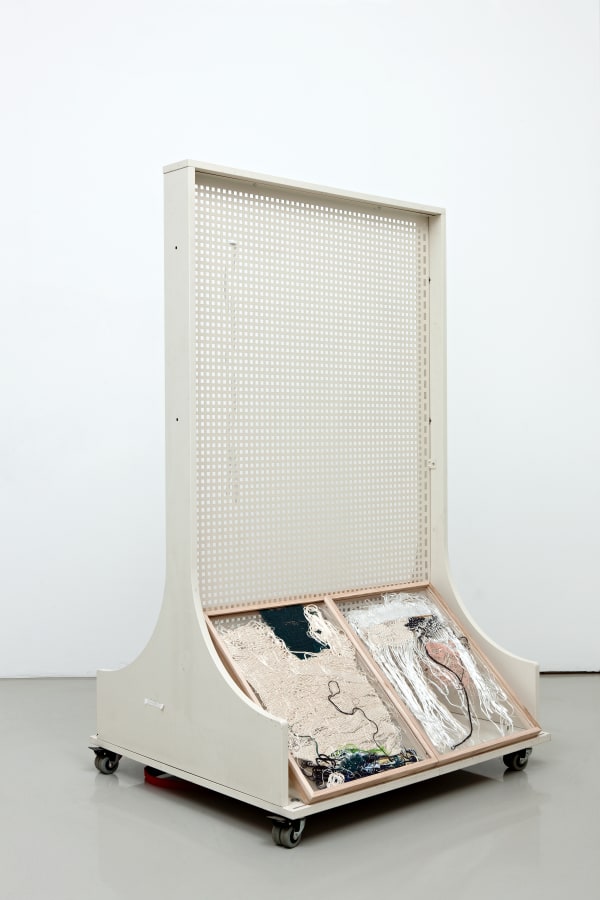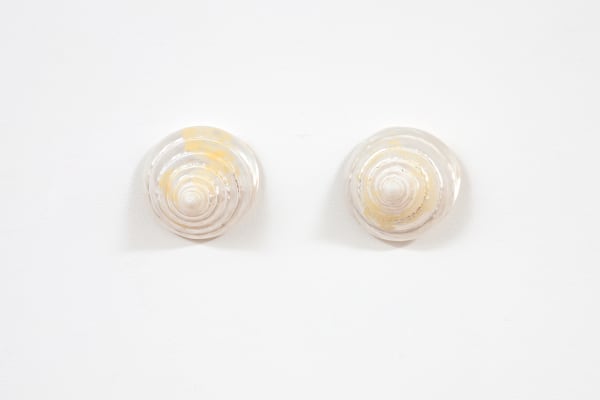ANN CATHRIN NOVEMBER HØIBO: "Christopher Burden On My Shoulders"
STANDARD (OSLO)
PRESS RELEASE
-----
ANN CATHRIN NOVEMBER HØIBO:
"CHRISTOPHER BURDEN ON MY SHOULDERS"
20.01.-18.02.2012 / PREVIEW: 20.01.2012 / 19.00-21.00
-----
STANDARD (OSLO) is proud to announce its first solo exhibition with Ann Cathrin November Høibo entitled "Christopher Burden on my Shoulders". Having graduated from the Oslo National Academy of the Arts last year, Høibo has made herself known for installations that rely on a layering of disparate elements and combining among others sculptures, framed works and textile works.While starting off studying the craft of tapestry weaving, her first solo exhibition aims at diffusing the distinction between that which is industrially, mechanically, or manually produced.
In 2002 the Belgian actor Olivier Gourmet was given the award for Best Actor at the Cannes Film Festival for his role in the movie "Le fils". Directed by Jean-Pierre and Luc Dardenne the film had Gourmet portraying a carpentry teacher in a training school for troubled teenagers. What made the decision a rather surprising one, was that the film provided Gourmet with oddly few lines and mostly had him appearing seen from behind. Time and time over the hand-held camera would be bringing the viewer to a corporeal proximity to his character, closing in on the back of his head, his glasses and his profile. Emotions would for the most part be expressed through plain movements and changes in posture. With the camera entirely in synch with his pace we would follow him around the workshop and with an equally extreme attention to details we would learn of the trade and manual labour of woodworking - the grain of timber, the density of various wood types, and the mundane, yet meticulous, work of cutting and carrying planks. The result was a sheer ordinariness where matter-of-factness turns materials into facts.
There is an odd correlation between those close-ups of Gourmet's neck and the confrontation with the untitled work greeting the viewer upon entering Ann Cathrin November Høibo's first solo exhibition. The same distorted silence results from a willful uncommunicativeness. Once more one tactile information becomes the primary source of information. The work - at a glance appearing to be a painting - takes form of a monochromatic white plane enclosed by a shadow frame made of ash wood. Moving closer the surface shows no traces of hand-made application, but rather reveals itself to be the machine-made texture of synthetic leather. The high gloss surface occurs simultaneously dull, durable and ageless, and perfectly matching what French philosopher Jean Baudrillard addressed when identifying a second order of simulation. Corresponding to developments of post-war consumer culture, synthetic leather was introduced as an affordable substitute to accommodate the proliferation of mass-reproducible copies of items. Høibo, however, takes an interest in the lacking anticipation of aging of the material, but also the fatigued level of industrial technology that produced it. What once was the material for the masses - a democratic one, so to speak - is here subject to an equally democratic composition applying a democratic method of pure appropriation. Isolated, inverted and possibly so re-invented, Høibo crafts a work motivated from specific material qualities that - while having a plurality of purposes - maintains a transparency of thought through the finished product. The dear and dutiful viewer granting his or her time carefully studying the monochrome might be conflicted between a self-emptying state of boredom and a state of heightened sensory capacities. The paradox of this proximity - one is reminded of - is that it establishes a distance between what we can see and what we can know.
What we do know, however, is that the first white monochrome ever executed also was a pure appropriation. At the exhibition Salon des Arts Incohérents - that was held at the Galerie Vivienne in 1883 - writer, artist and humorist Alphonse Allais' contribution was an empty sheet of white Bristol paper. The visual pun was accompanied by a verbal play: "Première communion de jeunes filles chlorotiques par un temps de neige ["First Communion of Anemic Young Girls in the Snow"]. As deadpan as Allais' humour comes across a mere 130 years later it nevertheless serves as a reminder that the pure isolation of the monochrome (whether this specifically or any monochrome) does not prevent interpretation or pictorial imagination. The works by Høibo are much aware of this condition and seem to fully relish the balancing act between the passive and the performative. Adding to the work described above is another monochrome of slightly different format and hue of white, as well as a group of sculptures making use of IKEA shelving units as raw material (once more white; she confesses to have played tennis in the past, but adds that this hardly can be the sole explanation as to why the colour keeps on recurring). The incompleteness they share seems to necessitate the location of a content outside of the work; the raw and make-shift character resulting in them functioning as pivot points, or, in lack of better words, as props. This is even more evident in another group of six sculptures; cast in bronze are rectangular blocks of dried noodles. The monosyllabic form and shelf-stable seriality suggest a fusing of a Donald Judd-esque rhythmic modulation and the poetry of a Carrefour supermarket. Michael Fried was of course early at pointing at the inherent theatricality of minimalist sculpture; that the viewer's failed attempts at extracting a narrative from these mute objects became a narrative itself. However, if theatricality makes sense as an aspect to Høibo's works it is rather as a tension, a dialectic montage (a term coined by Soviet filmmaker Sergei Eisenstein), or a strained state resulting from forces acting in opposition to each other. There is none of Fried's claim of exhausting of a narrative but instead a simple recognition of the fact that these works have contradictory connotations. Mute, modest and mundane, these sculptures of instant noodles are at one and the same time specific and generic, figurative and oblique, trivial and socio-economically charged.
Add to that: a keen interest in the tragicomic. Taking on the character of building blocks of a bored (and malnutrioned) life these sculptures also point towards matters of just as much public as personal relevance. In all their simplicity they also represent, more than simply resonate of, a current situation that might be referred to as post-capitalism. Høibo's choice of objects, such as instant noodles, synthetic leather and IKEA shelving units, have in common that they fit the description of 'inferior goods'. The term stems from consumer theory and refers to a good that decreases in demand when consumer income rises (as opposed to normal goods, for which the opposite is observed). Inferiority would here apply to an observable fact relating to affordability rather than a statement about the quality of the good. "As a rule, these goods are affordable and adequately fulfill their purpose, but as more costly substitutes that offer more pleasure (or at least variety) become available, the use of the inferior goods diminishes" (Wikipedia). These make-shift industrial materials objects serving during times of less, could not be at a further distance from the trade that Gourmet's character is teaching in "Le Fils" or the trade that Høibo learnt herself. The textures and rhythms of manual labor, whether it be weaving or carpentry, are at once irreducibly physical and saturated with an almost spiritual significance. Contrasting in both method and matter are four framed fragments of tapestries.The work process allows Høibo a material and methodical research that in itself pushes towards permutation. Here, the four weaves are stripped down beyond structural foundation towards disintegration, willingly accepting the category of fragment. Juxtaposed with the bronze sculptures and synthetic leather monochromes they make an odd conversation about a renewed relevance of 'arte povera'; not necessarily true to stylistic traits of the original movement but true to a time of actual poverty. If a term as 'recessional aesthetics' ever had a sense of purpose, there never was a more apt sculptural response than a cast of instant noodles.
-----
Ann Cathrin November Høibo is trained from Oslo National Academy of the Arts, Oslo, and Städelschule, Frankfurt am Main, from where she graduated in 2011. This is Høibo's first solo exhibition. Recent exhibitions include "Something in the Way", Lofoten International Art Festival, Kabelvåg; "When In Rome", Malta Contemporary Art, Valletta, and "The Human Pattern", Kunsthall Oslo, Oslo. Her exhibition at STANDARD (OSLO) will be followed by a solo exhibition at the Henie Onstad Art Centre, Oslo, opening in March, which will also be accompanied by a publication.
-----
Installation photography: Vegard Kleven














